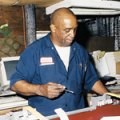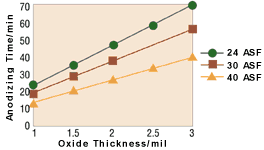Anodizing Process Eliminates Human Error
Universal's computerized anodizing system uses a unique blend of additives and pulsing techniques to build oxide coatings on aluminum. . .
Universal Metal Finishing has built a reputation in the automotive, electronic, diecasting and aviation industries for quality hardcoat anodizing. Now the company has implemented an innovative technology that allows it to give its customers the best hardcoating possible.
In the spring of 1995, Charles Roberts, president of Universal, Chicago, Illinois, took some parts to Newport Beach, California, to check out a new anodizing process. "When I saw how well the process worked, I was a convert," stated Mr. Roberts.
Universal did not bring the new technology in house immediately, however. Capital equipment upgrades were necessary so the computers could communicate with the rectifiers. Universal also rebussed some tanks. Upgrades were completed the fall of 1996, and in January 1997, Universal hooked up its first process line. The balance of the lines was upgraded in May 1997. Most of the processing parameters, such as pH and temperature have remained the same. The biggest difference is the chemistry and computer process control.
The process provides for increased surface hardness, greater abrasion resistance and excellent surface lubricity. Universal has also found that the process greatly reduces edge effects and crazing.
Universal's rectifier upgrades allowed it to interface with the MPCS computerized system that completely automates the actual run portion of the anodizing process. The system accepts job information entered by the operator at Universal, including alloy, target oxide thickness and surface area to obtain desired finish characteristics. The MPCS automatically controls and monitors Universal's rectifier output and monitors other bath parameters. After the production run, the system verifies the process with a printed job ticket with the operating parameters.
The MPCS is connected to the central monitoring system at METALAST, which provides operating support and updated anodizing recipes. Updated recipes are downloaded from the master monitoring system to each MPCS in the field.
The control system incorporates a proprietary rectification control algorithm that allows Universal's existing rectifiers to produce a pulsed output. This allows the anodizing solution to cool faster and reduce burning. Recirculating acid through the chiller keeps the baths cool.
The "special ingredient" in the new bath is a proprietary additive that prevents aluminum from burning and limits color fading and discoloration at high temperatures. It also provides Universal's parts, such as pistons, with a more uniform oxide.
"The bath requires a lot of attention," noted Mr. Roberts. "However, there are no hazardous materials in the discharge water, and there is little aluminum buildup in the anodizing electrolyte." Universal also uses polypropylene 10-, 12-, 18- and 20-ft tanks. The polypropylene makes it easier to control the anode:cathode ratio.
Another advantage for Universal is that it no longer has to tweak the concentrations in the bath to handle various alloys. Most of the alloys anodized at Universal are the standard 6061. It also anodizes 70 series and 20 series, which are mainly aircraft components. Extensive testing was done with the process prior to its implementation. Part of the research and development effort was experimenting with anodizing difficult alloys and dicecastings to prevent burning and, in certain cases, produce a maximum oxide thickness. The bath anodized all types of aluminum.
Testing revealed that the bath could produce the exact anodic oxide desired at any reasonable bath temperature. The process operates at various levels, depending on the type of surface finish needed on the various parts processed at Universal.
So, how difficult was it to convince its customers that the new bath was all it needed and more? "We were able to easily convert most of our 450 customers," stated Mr. Roberts.
Other customers, such as a major automotive manufacturer, came to Universal because through METALAST research and development problems were addressed and solved. The automotive manufacturer was having an adhesion problem with a typical production part. The company mounts a PC board to one side of the aluminum and plastic to the other. METALAST and the automotive manufacturer worked out a solution, and Universal provides the finish. All this was at no charge to Universal or the automobile manufacturer. "If we didn't have the link with METALAST, I don't think we could have had the job. This is a service they provide to us as part of our license," said Hobie Hewett, vice president. "The typical job shop cannot afford research and development such as this. METALAST does it for us, saving us the expense."
| TABLE I Corrosion Resistance Results |
|
| Alloy | Salt Spray Hours At Failure |
| 2024-T3 | 4566 |
| 3003-H14 | 4065 |
| 5005-H34 | 4065 |
| 6061-T6 | 4065 |
| 6063-T52 | 4732 |
| 7075-T6 | 4065 |
METALAST has also done some specific performance testing in addition to head-to-head comparisons between the process and conventional anodizing. Tests include corrosion resistance, thickness and coating formation rate. (See Tables I-III and Figure 1.)
"We thought we would have to charge a premium price for this process," stated Mr. Roberts, "but we are finding that is just not true." Universal can run the processes more quickly, and the savings in production time has translated into savings for the customers. "The major difference between our anodizing and all others is that while many anodizers are able to achieve a good surface most of the time, Universal can achieve it all of the time," concluded Mr. Roberts.
| TABLE II Target and Resultant Thickness of Anodic Coatings |
||||
| Type II Coating Thickness | Type III Coating Thickness | |||
| (mil) | (mil) | |||
| Alloy | Targeted | Resultant | Targeted | Resultant |
| 1100-H14 | 0.7 | 0.74±0.03 | - | - |
| 2024-T3 | 0.7 | 0.71±0.04 | 1.5 | 1.50±0.06 |
| 3003-H14 | 0.7 | 0.73±0.03 | 1.5 | 1.53±0.04 |
| 5005-H34 | 0.7 | 0.74±0.04 | 1.5 | 1.50±0.04 |
| 6061-T6 | 0.7 | 0.73±0.03 | 1.5 | 1.48±0.04 |
| 6063-T52 | 0.7 | 0.72±0.04 | 1.5 | 1.47±0.05 |
| 7075-T6 | 0.7 | 0.72±0.03 | 1.5 | 1.52±0.05 |
| TABLE III--Coating Formation Rate at Various Current Densities | |||||
| Coating Formation Rate (mil/min) | |||||
| METALAST-Type II | METALAST-Type III | ||||
| Alloy Type | 18 asf | 24 asf | 24 asf | 30 asf | 40 asf |
| 2024-T3 | 0.022 | 0.031 | 0.037 | 0.045 | 0.064 |
| 3003-H14 | 0.025 | 0.034 | 0.042 | 0.051 | 0.070 |
| 5005-H34 | 0.025 | 0.034 | 0.042 | 0.051 | 0.070 |
| 6061-T6 | 0.025 | 0.034 | 0.042 | 0.052 | 0.072 |
| 6063-T52 | 0.025 | 0.034 | 0.042 | 0.052 | 0.072 |
| 7075-T6 | 0.025 | 0.034 | 0.042 | 0.052 | 0.072 |
| 356 | 0.025 | 0.034 | - | 0.039 | 0.051 |
To learn more visit Chemeon Surface Technology LLC.
Related Content
Finishing Systems Provider Celebrates 150 Years, Looks to Future
From humble beginnings as an Indiana-based tin shop, Koch Finishing Systems has evolved into one of the most trusted finishing equipment providers in the industry.
Read MoreTop Shop Aces Outstanding Customer Service
More than a finishing shop, this anodizing, powder coating and vacuum resin impregnating business goes above and beyond for its customers by being a resource for whatever their finishing needs might demand.
Read MoreUnderstanding PEO Coatings
Using high-speed cameras and back side illumination (BSI) sensor technology to analyze plasma electrolytic oxidation.
Read More10 Anodizing Best Practices
Following this list of guidelines can help to increase the performance, cost effectiveness and quality for your anodizing operation.
Read MoreRead Next
Episode 45: An Interview with Chandler Mancuso, MacDermid Envio Solutions
Chandler Mancuso, technical director with MacDermid Envio discusses updating your wastewater treatment system and implementing materials recycling solutions to increase efficiencies, control costs and reduce environmental impact.
Read MoreA ‘Clean’ Agenda Offers Unique Presentations in Chicago
The 2024 Parts Cleaning Conference, co-located with the International Manufacturing Technology Show, includes presentations by several speakers who are new to the conference and topics that have not been covered in past editions of this event.
Read MoreEducation Bringing Cleaning to Machining
Debuting new speakers and cleaning technology content during this half-day workshop co-located with IMTS 2024.
Read More















.jpg;maxWidth=300;quality=90)








